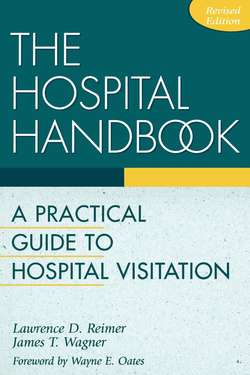Читать книгу Hospital Handbook - James T. Wagner - Страница 13
На сайте Литреса книга снята с продажи.
Bibliography
ОглавлениеCousins, N. Anatomy of an Illness. New York: W.W. Norton Co., Inc. 1979.
The author recovers from a serious illness through following standard medical regimens in addition to his own prescriptions. This book is now a classic and highlights partnership between physician and patient.
Cousins, N. The Healing Heart. New York: W.W. Norton Co., Inc., 1984.
Cousins offers personal reflections on ways he managed his recovery from a significant heart attack through monitoring his own anxiety and developing a partnership with medical staff.
Florell, J.L. “Wholistic Health and Pastoral Counseling.” Journal of Pastoral Care. Vol. XXXIII, No. 2, June 1979, pp. 96–103.
Presents an overview of approaches to wholistic health care in a variety of settings.
Goldsmith, J.C. Can Hospitals Survive? Homewood, Il.: Dow Jones-Irwin, 1981.
The author puts forth a thoughtful and insightful discussion of the major changes occurring in the health care field. He describes the already intense competition among hospitals, which is resulting in restructuring of the entire system. Consumer choice as well as cost consciousness are guiding principles which will result in the closing of some facilities and the survival of others.
Tubesing, D.A. Wholistic Health. New York: Human Sciences Press, 1979.
The author provides an excellent comparison and contrast between traditional models of providing health care and those which include a wholistic philosophy. As a single resource it provides an excellent discussion of the issues.
Westberg, R. “From Hospital Chaplaincy to Wholistic Health Center.” Journal of Pastoral Care. Vol. XXXIII, No. s, June 1979, pp. 76–82.
Reports on developing programs bringing patients into the diagnostic and healing process.
1. In April 1983, the President's Commission for the Study of Ethical Problems in Medicine and Biomedical and Behavioral Research published a controversial report entitled Securing Access to Health Care (U.S. Government Printing Office, s/n 040-000-00472-9) which said, in part, that “society has the responsibility ethically to provide every person with an adequate level of health care without excessive burden to anyone.” The Commission did not say that everybody in society who could not afford it privately or cannot get it through other resources, is entitled to all the care that the person wants or all the care that may be beneficial. This is a position quite different from that which is politically expressed but may, in fact, more accurately describe what occurs in our society.
2. Meg Cox, “This Doctor Says: Take Two Aspirins and I'll Call on You in the Morning,” The Wall Street Journal, January 5, 1984, p. 25. The best available figures indicate that physician house calls dropped to 17 million in 1975 from 60 million in 1960.
3. Social Security Amendments of 1983, Pub. L No. 98–21, 601–07, 97 Stat. 65, 149–72 (1983). (Prospective payment for Medicare inpatient hospital services based on DRGs.)
4. F.H. Kerr, “Considering a New Structure: The Health Services Holding Company,” Law, Medicine and Health Care, Vol. 11, No. 5, October 1983, p. 214.
5. J. Naisbitt, Megatrends. New York: Warner Books, 1982, pp. 39–53.
6. “Deciding to Forego Life-Sustaining Treatment,” President's Commission for the Study of Ethical Problems in Medicine and Biomedical and Behavioral Research, March 1983. (Suite 555, 2000 K Street, N.W., Washington, D.C. 20006.)
